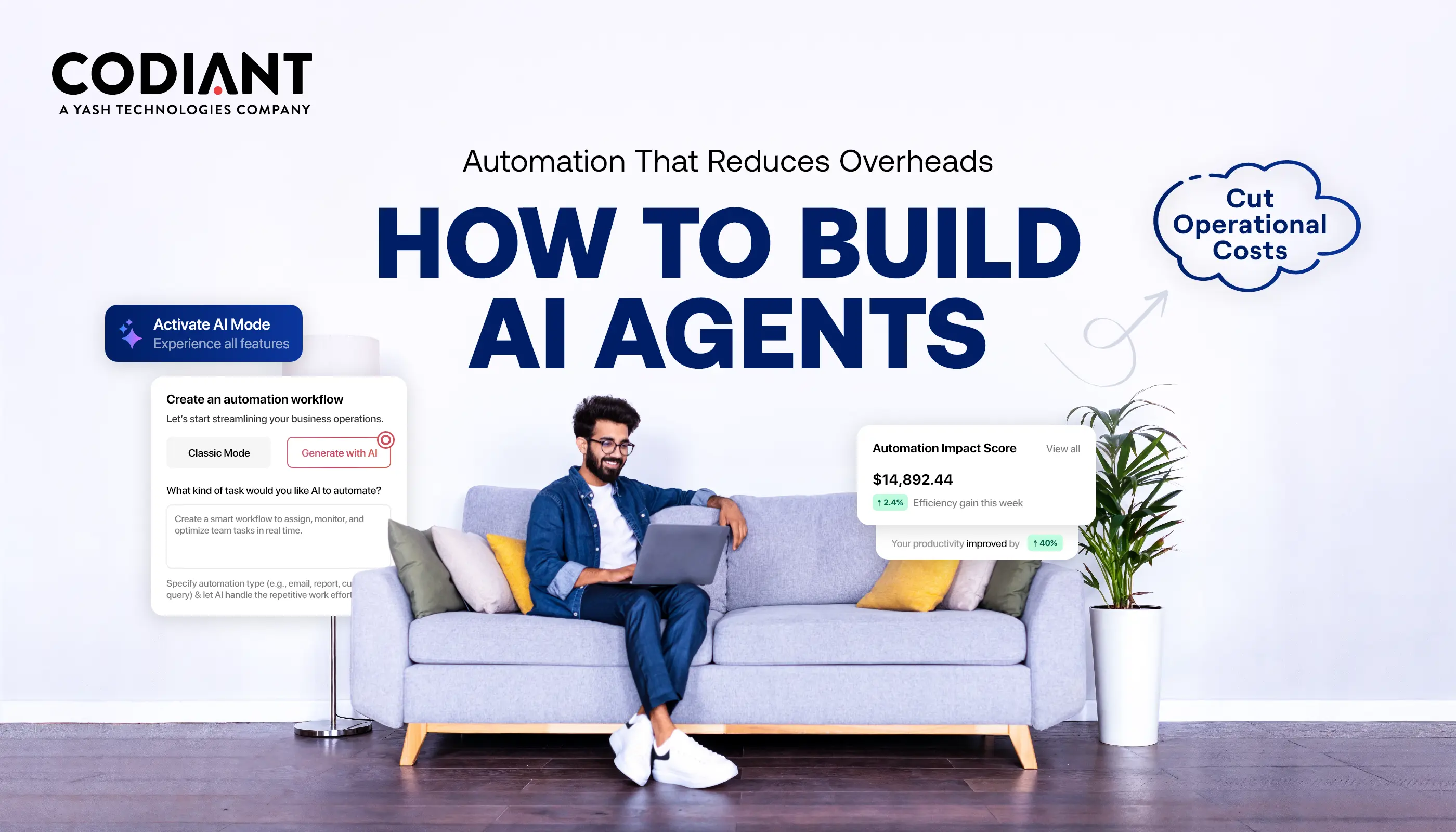Why You Should Hire Full Stack Developers for Complex Projects
Table of Contents
Subscribe To Our Newsletter
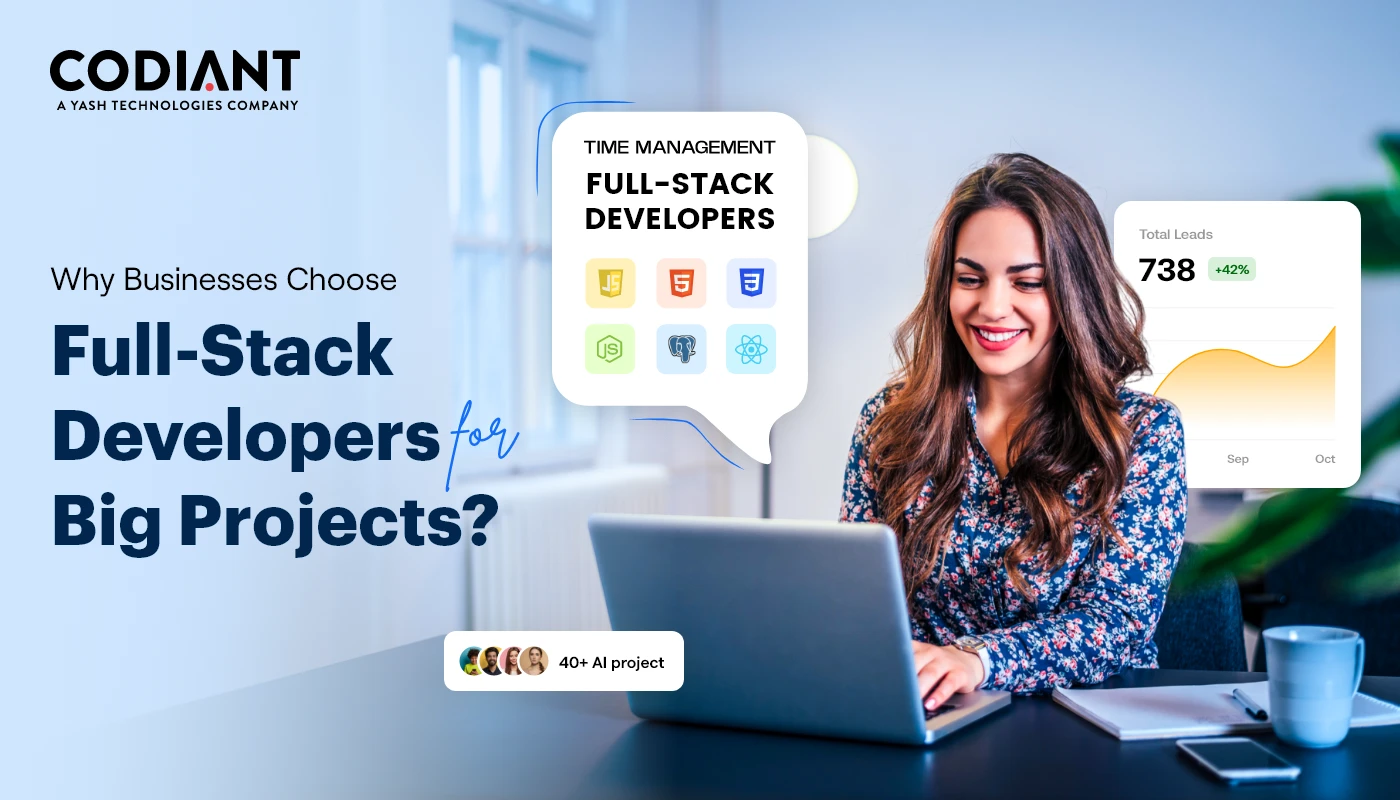
In a Nutshell:
Full stack developers = all-rounders
- Work on both front end (user interface) and back end (logic, database)
- Step in wherever gaps appear
Benefits of full stack developer hires
- Faster delivery of features and MVPs
- Lower costs with fewer specialist hires in early stages
- Better teamwork since they understand both sides
- Software developer roles in the U.S. are projected to grow ~17% from 2023 to 2033, adding ~327,900 new jobs
Full stack development advantages for startups
- Lean teams save time and money
- One person can handle multiple roles
- Perfect for fast pivots and quick launches
Advantages of full stack developer in enterprises
- Break down silos between teams
- Improve collaboration across departments
- Keep large projects moving smoothly
Why hire a full stack developer?
- They see the big picture
- Solve problems across the whole system
- Keep projects scalable, adaptable & on track
Let’s start with the obvious- software projects are messy. They never roll out like those neat diagrams in pitch decks where every arrow points forward and nothing breaks. Complex projects – think SaaS platforms, enterprise dashboards or multi-sided marketplaces – are basically living organisms. They grow, mutate & sometimes throw tantrums.
Now, when you’re managing that kind of chaos, the question isn’t just “Do we have enough developers?” The real question is- Do we have the right kind of developers? And here’s the thing- full-stack developers often turn out to be the unsung superheroes in these scenarios.
We’ll get into the benefits of full stack developer hires, unpack the full stack development advantages & look at why both start-ups and enterprises swear by them. But let’s start with a story.
Why Full Stack Developers Are Essential in Modern Software Projects?
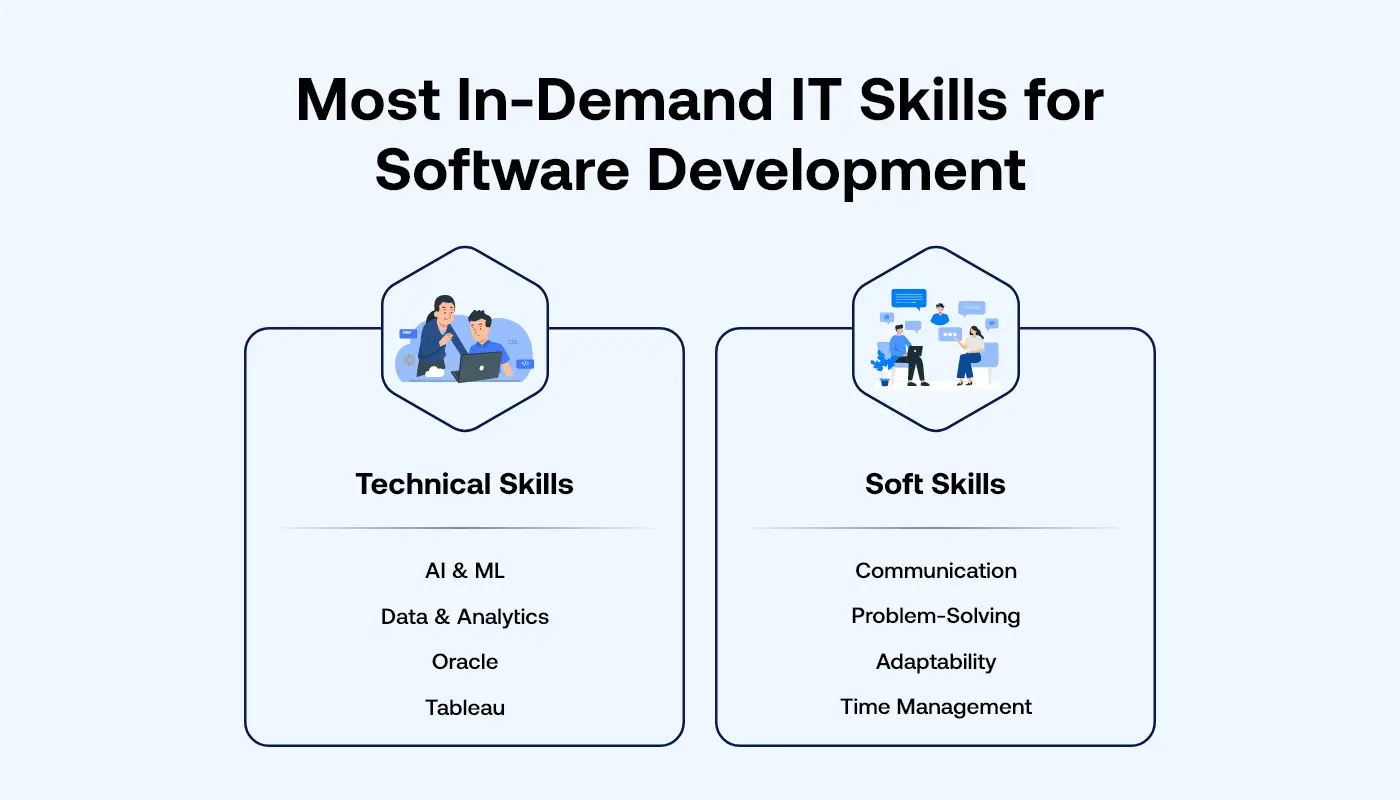
Imagine you’re opening a restaurant. You could hire one person who only grills the steak, another who only chops vegetables & someone else who just runs the oven. That works – until one of them calls in sick and the kitchen goes sideways.
Now compare that to hiring a chef who can do it all- slice, dice, sauté, even plate it up if needed. That’s your full-stack developer. They may not replace a 20-year steak master, but when the dinner rush hits, they keep the kitchen moving.
Complex software projects are exactly like that dinner rush – except they stretch over months of deadlines, constant feature requests & unexpected technical problems. When you have a multi-skilled AI developer in your team then this means that there will be someone who can step in wherever the gap appears and keep things running.
So, why are Full Stack developers essential in modern software projects?
- Versatility- They can handle both front-end & back-end work which reduces dependency on multiple people.
- Speed- Projects completion gets faster when one developer can complete an entire feature from start to finish.
- Problem-Solving- They see the whole picture which makes it easier to find the root cause of issues.
- Flexibility- When priorities shift (and they always do), multi-skilled developers can adapt quickly.
- Cost-Effectiveness- Fewer handoffs and fewer specialists needed early on saves both time and budget.
Ready to Add Agility to Your Team?
Don’t let skill silos slow you down. Hiring a full-stack developer gives your project the versatility, speed & problem-solving edge it needs. Start building smarter and faster today.
What is a Full-Stack Developer?
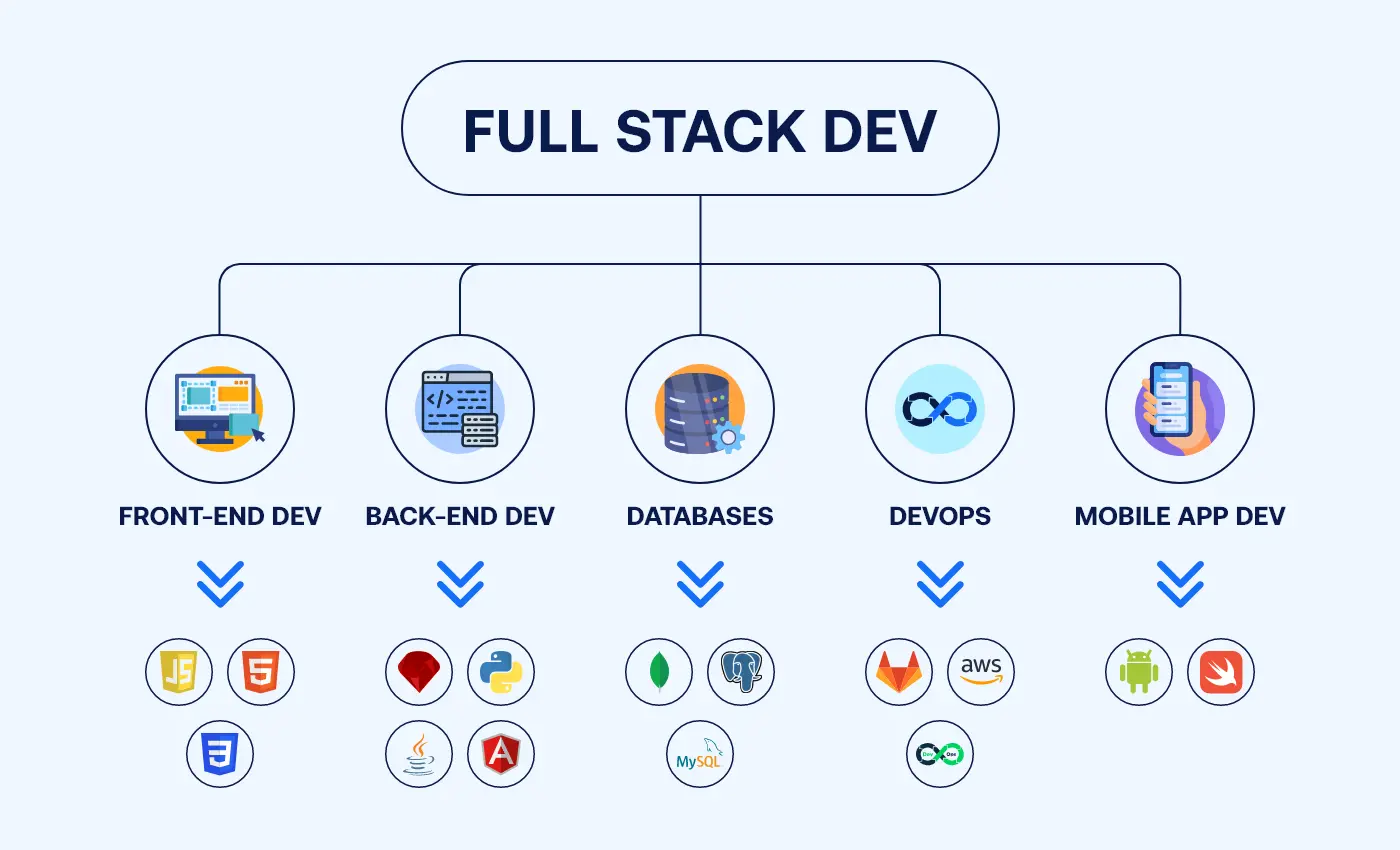
A full-stack developer is a person who can work on both the front end and the back end of a software project.
- Front end is what people see and use on their screen. This includes the design, buttons, forms, menus and the overall look of the website or app. It’s about making the experience easy and clear for users.
- Back end is the hidden part that powers the system. It manages the database, runs the logic & connects everything together so the app works properly.
- In between there are also servers, APIs & sometimes extra tasks like managing hosting or setting up tools that helps the app to run faster. A full-stack developer generally helps with these tasks also.
A full-stack developer knows how all the parts of a system work together. They can create a feature from beginning to end – how it looks on the screen and how it works behind it. They do not take the place of experts who focus on just one part but they’re important because they connect both sides and help the project move smoothly.
Why Hire a Full Stack Developer?
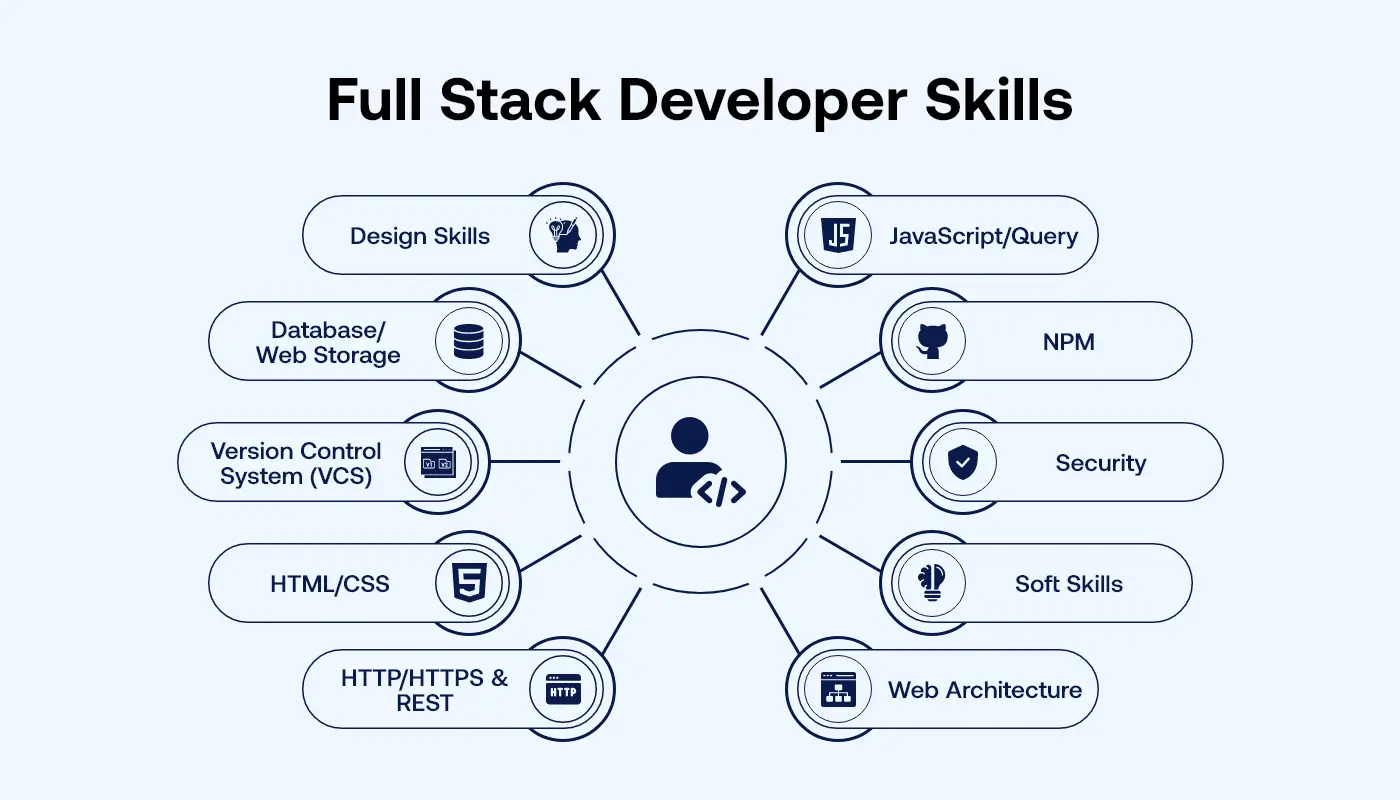
When a project becomes big and complicated, there are many different parts to manage. Several teams have to work together & this can cause delays. A full-stack developer cannot fix every issue, but they can connect the pieces and help the project move more smoothly.
End-to-End Perspective
Front-end developers work on user experience like buttons, forms & layouts. Back-end developers work on hidden parts such as databases and servers. A full-stack developer knows both sides. This helps them understand how design choices affect the system and how back-end decisions impact the user’s experience.
Reduced Dependencies
Often, one team has to wait for another before they can continue. For example, the front-end team might wait for the back-end team to build an API & then the QA team has to wait for both. These delays slow the project. A full-stack developer can do tasks from both sides, which reduces waiting and speeds up progress.
Context Switching Without the Headache
Front-end and back-end development are like speaking two different languages. A specialist may take extra time when switching between them. A full-stack developer is already skilled in both, so they can move easily from one to the other without slowing down.
Cost-Effectiveness
Hiring many specialists at the start can be costly. For small teams or start-ups, this may not be possible. A full-stack developer can take on several roles, which saves money and resources. You don’t need a large team right away & you can still build a working product. This is one of the main advantages of full stack developer hires.
The Benefits of Full Stack Developer in Complex Projects
When projects become large and complicated, having a full stack developer on the team can make a big difference. Here’s why-
1. Holistic Problem-Solving
A full stack developer looks at the whole system, not just one part. If something breaks on the back end, they don’t stop there. They check how it affects the front end, the database & even other features. This way, the project stays balanced and problems don’t spread.
2. Faster MVP Delivery
Start-ups need to move quickly and show results fast. A full stack developer can build both the front end and the back end without waiting for separate teams. This means the first version of the product or MVP, can be ready sooner and tested with real users right away.
3. Better Communication
Many project delays come from teams not understanding each other. Since full stack developers know how both sides of the system work, they can explain things clearly and connect the dots between teams. This makes teamwork smoother and reduces mistakes.
4. Flexible for Change
Big projects often change direction – features get redesigned or new tools are added. Full stack developers are used to working in many areas of the system, so they can adjust quickly. Instead of slowing things down, they help the project move forward.
5. Ready to Scale
Scalability is about growing without breaking. It’s not only about handling more users but also about growing the team. Full stack developers make it easier for new members to learn because they understand the whole system. They can guide others and step in wherever extra help is needed.
Also Read: How to Hire a Dedicated Development Team?
The Rising Complexity of Software Projects in 2025 and Beyond
Technology isn’t slowing down-it’s accelerating faster than teams can adapt. Businesses today aren’t just building apps; they’re building ecosystems that must work across devices, data layers & cloud infrastructures. The result?
A software landscape that’s more interconnected-and more complex-than ever before.
Let’s break down what’s driving this surge in complexity and why companies are rethinking their development approach.
1. Multi-Platform Expectations- Web, Mobile & Everything In-Between
Consumers now expect digital experiences that follow them everywhere-on their phones, laptops, smartwatches & even connected cars.
That means brands can no longer think in silos. A single idea must scale seamlessly across-
- Mobile apps with unique UI needs
- Web dashboards with heavier logic
- Third-party integrations powered by APIs
- IoT or wearable extensions
This is what we call the API-first era-where backend systems must support multiple frontends simultaneously.
In such environments, context switching kills efficiency.
When frontend and backend teams work separately, every small change—like adding a new checkout flow-requires multiple handoffs. Full-stack developers solve this by designing, developing & debugging across the entire flow. They don’t just code; they connect the dots, much like how outsourcing AI development streamlines complex tech processes for faster, integrated results.
2. AI Integration, Cloud-Native Apps & the Rise of Microservices
Every business wants to “add AI,” but integrating it into live systems is not plug-and-play.
AI models demand-
- Clean data pipelines
- Continuous training and deployment
- Scalable compute on cloud infrastructure
Meanwhile, the industry has shifted from monoliths to microservices breaking one big application into 50+ smaller ones that talk to each other via APIs. It improves scalability but makes coordination tougher.
To maintain this moving puzzle, companies need developers who can see across services, infrastructure & user flows.
Full-stack developers shine here-they understand how a change in a data model affects both API behavior and UI rendering, ensuring smooth, end-to-end performance.
Example- Netflix runs over 1,000 microservices. Full-stack engineers coordinate frontend, backend & DevOps pipelines to keep the system running without interruption.
3. Security, Compliance & Scalability Challenges
With more integrations come more vulnerabilities.
APIs expose endpoints. Cloud storage adds data risks. And regulations-GDPR, HIPAA, SOC 2-demand airtight compliance.
A single oversight, like an unencrypted endpoint or misconfigured token, can cost millions.
That’s why companies are prioritizing developers who can think security-first, not just code-first.
Full-stack professionals can-
- Implement backend access controls
- Manage API authentication
- Secure frontend data flows
- Scale infrastructure while staying compliant
They approach scalability and security as two sides of the same coin-ensuring that as systems grow, they don’t crack under pressure.
4. Speed, Iteration & the Need for Continuous Deployment
Markets evolve in weeks, not months.
Start-ups pivot overnight. Enterprises launch new digital services every quarter. To keep up, development cycles have to be faster-and infinitely more flexible.
This is where CI/CD (Continuous Integration and Continuous Deployment) pipelines come into play.
Code must move from concept → testing → deployment in hours, not days.
But managing that speed requires a full understanding of the entire stack- front-end performance, backend APIs, databases & automation scripts.
Full-stack developers enable this agility. They can troubleshoot a database timeout, optimize an API response & fix a UI glitch-all without waiting for another team’s bandwidth.
Full Stack Developers for Startups And Enterprises
The role of a full-stack developer may look slightly different in a start-up compared to a large enterprise, but the underlying value they bring-speed, flexibility and cohesion-remains constant. They act as the connective tissue between teams, technologies and timelines.
Startups- Agility, Efficiency and Speed to Market
Startups run on limited time, tighter budgets and relentless ambition. Every resource has to count and every role often stretches across multiple responsibilities. In such an environment, full-stack developers become game changers.
Instead of needing separate hires for design, frontend, backend and infrastructure setup, a single full-stack developer can handle the entire development cycle-building UI components, setting up APIs, configuring databases and even deploying to the cloud.
This cross-functional ability means-
- Faster MVP Launches- Startups can bring ideas to life quickly, test them with real users and adapt based on feedback without long handover chains.
- Lower Operational Costs- Fewer hires mean reduced payroll and management overhead, allowing funds to go toward growth or marketing.
- Flexible Experimentation- When the business pivots (and it often does), full-stack developers can shift gears instantly-tweaking architecture, adding features, or integrating third-party tools without waiting on separate teams.
- Holistic Ownership- They see the product as one cohesive unit instead of isolated parts, which fosters accountability and smarter decision-making.
In short, a start-up backed by even a few capable full-stack developers can operate like a much larger team-moving fast, iterating often and staying lean without compromising on innovation.
Enterprises- Bridging Silos and Enhancing Collaboration
In enterprises, the challenge isn’t speed-it’s coordination. Large teams are split across departments, tools and time zones. Projects often slow down because front-end, back-end, DevOps and QA teams work in silos with limited overlap. That’s where full-stack developers quietly transform how work gets done.
A full-stack developer in an enterprise doesn’t just write code-they connect systems and people. They understand how the front-end experience aligns with backend logic, how APIs interact with microservices and how deployments affect performance. This wide-angle view allows them to spot integration issues early and streamline communication across functions.
Their impact can be seen in-
- Reduced Bottlenecks- They bridge gaps between teams, ensuring handoffs happen smoothly and features move from prototype to production faster.
- Cross-Functional Problem Solving- When something breaks, they can trace the issue across layers instead of waiting for another team to investigate.
- Improved DevOps Alignment- They often collaborate with DevOps engineers to optimize CI/CD pipelines, automate testing and maintain deployment consistency.
- Scalable Architecture Thinking- Because they understand multiple layers, they help architect solutions that scale effectively-across servers, APIs and user interfaces.
For enterprises undergoing digital transformation, full-stack developers are the integrators who bring agility back into massive systems. They make big organizations move with the nimbleness of start-ups-without sacrificing governance or quality.
The Common Thread
Whether it’s a start-up chasing product-market fit or an enterprise streamlining digital operations, full-stack developers are the constant force keeping complexity in check.
Start-ups rely on them for momentum.
Enterprises depend on them for cohesion.
Different challenges, same solution- developers who can see across the stack, bridge silos and turn moving parts into a working whole.
Full Stack Developers vs Specialists- Which Is Better?
You might be wondering – why not just hire a front-end expert and a back-end expert instead of one full-stack developer?
Fair question. After all, specialists are the masters of their craft. They can make your UI animations buttery smooth, or ensure your backend scales effortlessly under load. They dive deep, fine-tune performance & perfect the details within their domain.
But here’s the truth – depth alone doesn’t win in complex projects; connection does.
Modern software projects aren’t just a collection of parts. They’re interconnected ecosystems of front-end design, backend logic, APIs, databases & cloud layers that need to work in perfect harmony.
If specialists build the pieces, full-stack developers make them talk. They understand both ends of the spectrum – what the user sees and what happens behind the scenes. This broader visibility helps them bridge gaps, prevent breakdowns & make sure that what’s built on one side doesn’t break the other.
Imagine building a bridge- specialists are the engineers designing each section in detail, while the full-stack development services is the architect ensuring those sections align perfectly from both shores. Without that alignment, you end up with two beautifully built halves that never meet in the middle.
So, when it comes to the “who’s better?” debate, the answer isn’t either-or – it’s both, together.
- Specialists bring mastery.
- Full-stack developers bring unity.
- And when combined, they bring velocity and cohesion to the entire development cycle.
In essence, specialists go deep. Full-stack developers go wide. And complex projects need both depth and breadth to thrive.
Why Hiring a Full Stack Developer Early Saves Time and Costs?
Timing is everything in product development. Hiring the right person too late can cost months in delays, lost opportunities & technical debt that piles up like unpaid bills.
Many companies assume they can start small – hire individual specialists first and bring in a full-stack developer later when the project grows. On paper, this looks efficient. But in reality, it’s a trap. By the time the project reaches complexity, the architecture is already set, the codebase is siloed & communication gaps have formed. That’s when a full-stack developer ends up spending more time fixing what could’ve been prevented from day one.
Let’s look at how having a full-stack developer early on changes the game-
1. Early Stage- From Idea to MVP Faster
In the early stage, speed and experimentation matter more than perfection. A full-stack developer can prototype, test & iterate quickly – without waiting on handoffs between separate front-end and back-end teams.
They can design a UI, wire it to an API & connect it to a database all in a single sprint. That agility helps founders validate product ideas, attract early investors, or even test new features in live environments faster than competitors.
Essentially, they act as your technical Swiss Army knife – capable of taking an idea from whiteboard to working demo in record time.
2. Growth Stage- Maintaining Balance as Complexity Grows
As your user base scales and new features roll out, the system inevitably grows more complex. Multiple services, integrations & APIs start interacting – and that’s where cracks begin to show.
A full-stack developer acts as a stabilizer. They understand how every new feature affects performance, scalability & user experience. Because they can see across layers, they can refactor smarter, optimize connections between modules & ensure that nothing breaks as you scale.
In other words, they’re the ones keeping your tech stack lean, balanced & predictable while everything around it grows.
3. Mature Stage- Connecting Silos and Driving Synergy
At the enterprise level, large teams often struggle with silos. Designers focus on UX. Front-end developers focus on component libraries. Back-end teams handle APIs and data. And DevOps manages deployments. But without a bridge between these silos, progress slows down and friction rises.
Full-stack developers serve as connectors and interpreters. They can communicate in the “languages” of each domain, understand interdependencies & translate business goals into technical alignment. This makes them invaluable during cross-team integrations, migrations, or architecture overhauls.
Beyond Skill – It’s About Momentum
What full-stack developers really bring to the table isn’t just technical range – it’s momentum.
They eliminate bottlenecks, reduce dependencies & keep development flowing continuously instead of stopping at every boundary. They don’t just write code – they unblock progress.
At every stage – from ideation to scale – their ability to connect dots, think end-to-end & stay hands-on across multiple technologies helps teams stay agile, aligned & always moving forward.
So yes, hiring a full-stack developer early is a cost-saving decision. But more than that, it’s a momentum-saving decision – one that keeps your project alive, evolving & always one step ahead of the next bottleneck.
Common Misconceptions About Full-Stack Developers
Full-stack developers are often misunderstood. Here are a few common myths-
“They’re jacks of all trades, masters of none.”
That’s not true. Many full-stack developers are really good at one main area while also knowing enough about others to get things done. This mix makes them flexible and useful.
“They can replace entire teams.”
A full-stack developer can’t do the work of a whole team alone. Their real power is in connecting different roles and helping everyone work together smoothly.
“Only startups need them.”
It’s not just startups. Big companies also hire full-stack developers to speed things up, reduce delays & make complex projects easier to manage.
The Business Case- ROI of Hiring Full-Stack Developers
A mid-sized healthtech start-up was building a patient portal – appointment booking, prescription tracking, video consults, the works. Initially, they thought they needed separate hires- a front-end specialist, a back-end engineer & maybe a DevOps resource. That’s three salaries before they even had a working prototype.
Instead, they hired one senior full-stack developer. Within four months, that single hire delivered a functional MVP- patients could log in, schedule appointments & doctors could update records. When investors saw the live demo, funding came through – six months ahead of plan.
Here’s what changed for them-
- Less headcount → One person covered multiple roles, so the payroll stayed lean while results stayed fast.
- Faster launch → Hitting the market months earlier meant they grabbed early adopter clinics before competitors.
- Fewer delays → No waiting around for “the other team” to finish their part. One person could connect all the dots.
The ROI wasn’t just lower hiring costs. It was the chance to land investors early, capture market share & prove traction before rivals even had a prototype.
How to Build a Full-Stack Team the Right Way
Building a full-stack team is not just about hiring developers with multiple skills-it’s about constructing a cohesive unit that understands business goals, technology architecture & rapid execution. The right full-stack team is one that moves with agility, scales with demand & stays aligned with the organization’s long-term product vision. Here’s how CTOs and project managers can build such teams with clarity and purpose.
Defining Project Scope and Skill Requirements
Every successful hiring journey begins with precision in defining the project scope. Before scanning for talent, outline the product’s technical architecture, core features, scalability requirements & integration dependencies.
For instance, a fintech dashboard dealing with high-frequency transactions may demand robust back-end security and database optimization, while an eCommerce SaaS solution might prioritize user experience and API flexibility.
Once the scope is clear, define the technical requirements under three dimensions-
- Core Stack- Primary languages and frameworks such as React, Angular, Node.js, Python, or .NET.
- Complementary Skills- Database expertise (MongoDB, PostgreSQL, MySQL), API integration, version control (Git) & CI/CD pipelines.
- Scalability Enablers- Cloud deployment (AWS, Azure, GCP), containerization (Docker, Kubernetes) & testing automation tools.
Pro Tip- Map business priorities directly to tech requirements. For instance, if faster time-to-market is key, prioritize candidates skilled in frameworks that support rapid prototyping and MVP builds.
Evaluating Candidates- Technical + Architectural Mindset
A strong full-stack developer is more than a coder-they’re a system thinker. While technical proficiency ensures short-term output, an architectural mindset ensures long-term maintainability.
During the hiring process, evaluate candidates across four layers-
- Foundational Expertise- Proficiency in front-end and back-end languages, cloud deployment, RESTful APIs & database design.
- Architectural Vision- Ability to design modular and scalable systems, select the right tech stack & foresee integration challenges.
- Problem-Solving Mindset- Real-world problem scenarios during interviews reveal adaptability under constraints.
- Collaboration Fluency- Comfort with agile ceremonies, version control workflows & communication tools like Jira, Confluence, or Slack.
Include practical assessments-such as building a small full-stack module or integrating an API-to gauge real-world performance. This ensures candidates don’t just “know” multiple technologies but can connect them effectively.
Recommended Tech Stack Combinations by Project Type
While full-stack developers are adaptable, aligning the right tech stack to the business model enhances productivity and reduces rework.
| Project Type | Recommended Stack | Why It Works |
| SaaS Platforms | React + Node.js + MongoDB (MERN) | Ideal for rapid iteration, flexible APIs & scalability. |
| FinTech Apps | Angular + .NET Core + SQL Server | Strong type safety, enterprise-grade performance & compliance-ready. |
| eCommerce Solutions | Vue.js + Laravel + MySQL | Fast development cycles, modularity & SEO-friendly architecture. |
| AI/ML-Driven Apps | Python (Django/Flask) + React + PostgreSQL | Smooth data handling and integration with AI pipelines. |
| Enterprise Portals | ASP.NET MVC + React + Azure | Seamless integration with Microsoft ecosystem and robust security. |
Selecting the right stack helps streamline workflows, attract developers with relevant expertise & set a strong architectural foundation for future scaling.
Balancing Specialists with Full-Stack Leads
Complex projects often require a blend of generalists and specialists. A balanced structure allows the agility of full-stack developers while leveraging deep expertise where necessary.
The Ideal Composition-
- Full-Stack Leads- Architects who oversee the overall solution, bridging UI, back-end & infrastructure.
- Specialists- Experts in niche areas such as cloud security, AI integration, DevOps, or UI/UX.
- QA & Automation Engineers- Focused on ensuring consistent quality across releases.
This hybrid team structure enhances cross-functional collaboration without overloading full-stack developers with specialized tasks beyond their domain depth.
Insight- Full-stack developers thrive as “connectors,” not as replacements for specialists. Their role is to unify vision and accelerate decision-making across silos.
Collaboration, Tools & Agile Processes
Even the best developers can underperform in a fragmented process environment. Implementing the right collaboration framework ensures that full-stack teams function as a synchronized engine.
- Agile as a Culture, Not Just a Process- Adopt two-week sprint cycles with clear deliverables, daily stand-ups & iterative feedback loops.
- Version Control & CI/CD- Use Git, Jenkins, or GitLab pipelines to automate testing and deployment.
- Project Visibility Tools- Jira, Asana, or Trello for task tracking; Miro or FigJam for design collaboration.
- Cloud & Containerization- Docker, Kubernetes & AWS Amplify help maintain environment consistency across dev, staging & production.
- Documentation Discipline- Maintain living documents via Confluence or Notion to preserve tribal knowledge and accelerate onboarding.
An integrated toolchain paired with agile governance ensures transparency, accountability & faster go-to-market cycles-key differentiators for high-stakes digital projects.
Full-Stack Developer Hiring Roadmap
Below is a practical framework for CTOs and PMs to move from planning to execution while hiring a full-stack team-
| Stage | Key Activities | Outcome |
| 1. Define Role & Scope | Identify tech stack, complexity & delivery timelines. | Clear hiring criteria aligned to business goals. |
| 2. Source Candidates | Partner with specialized tech recruiters or offshore teams. | Access to a diverse global talent pool. |
| 3. Evaluate Skills | Conduct technical + architectural interviews, coding tasks & culture fit assessments. | Shortlist multi-skilled, adaptable candidates. |
| 4. Hire & Onboard | Align hires with agile processes, tools & code standards. | Seamless integration into active projects. |
| 5. Continuous Upskilling | Offer learning programs for AI, DevOps & cloud skills. | Future-ready, growth-oriented full-stack team. |
In essence- Full-stack teams are the backbone of modern digital transformation-where speed, alignment & scalability converge.
When You Shouldn’t Hire Full-Stack Developers?
Full-stack developers bring unmatched versatility – they understand how the front end, back end & infrastructure connect to deliver a unified experience. But that doesn’t mean they’re the right fit for every situation. Certain projects demand deep, specialized expertise that goes beyond the “generalist advantage.” Knowing when not to hire full-stack developers helps you build stronger, more balanced teams that deliver both speed and precision.
1. Deep Tech Domains Like AI, AR/VR, or Embedded Systems
Projects rooted in advanced technologies – such as machine learning, augmented reality, blockchain, or IoT firmware – often require highly specialized skills. These domains are built on complex algorithms, hardware dependencies & advanced mathematical modeling. For instance, developing a computer vision system or training a large AI model demands data scientists, ML engineers & GPU optimization experts who understand the science beneath the code.
A full-stack developer can complement these efforts by managing APIs, dashboards, or integrations, but they won’t replace the expertise required to push deep-tech innovation forward. In short, if your project’s success depends on research-grade precision or hardware-level optimization, you’ll need specialists.
2. Massive Enterprise Systems with Strict Silos
In large enterprises – think banking platforms, healthcare management systems, or logistics ERPs – each layer of technology is handled by its own dedicated unit. There are entire teams for security, DevOps, infrastructure, QA & database management. These environments are governed by strict compliance, scalability & uptime requirements.
Full-stack developers may struggle to work effectively here because responsibilities are deeply segmented. Instead, they function best as bridge roles – helping different departments align or translating technical requirements across silos. But as primary contributors in these ecosystems, they can quickly hit operational limitations.
3. Maintenance or Legacy Projects
If your project has already matured – with a stable architecture, legacy codebase & fixed tech stack – the focus usually shifts from innovation to maintenance. You need developers who know the existing system inside out and can make targeted, low-risk changes.
A full-stack developer’s value lies in versatility, so hiring them for minor bug fixes or version upgrades might be excessive. A smaller, specialized maintenance team can handle such tasks more efficiently and cost-effectively.
4. The Smart Middle Ground: Blend Full-Stack and Specialist Talent
The sweet spot often lies in hybrid team composition. Use full-stack developers as architectural leads who connect design, development & deployment. Surround them with domain experts who go deep into databases, AI models, or infrastructure. This blend creates agility without sacrificing expertise.
Full-stack development isn’t about doing everything alone – it’s about understanding every layer well enough to connect the dots intelligently.
In Summary
Complex projects need more than just coders. They need bridges. They need people who see the big picture without ignoring the small details.
And that’s the benefits of full stack developer hires in a nutshell- adaptability, context & speed. Call it the secret sauce or the glue in the system – either way, it’s why both startups and enterprises lean on them when things get complicated.
Instead of asking “Who can just write the code?”, the smarter question is- “Who can keep the whole system moving in sync?”
Because when projects get complex, progress isn’t about more lines of code. It’s about making every line work together.
One Hire. Endless Possibilities.
Skip the chaos of multiple handoffs – get features shipped faster with full-stack developers.
Frequently Asked Questions
A skilled full stack developer knows front-end tools (like HTML, CSS & JavaScript) and back-end languages also (like Node.js Python, PHP) databases, APIs & cloud basics. They are also good with soft skills like problem-solving and teamwork also matter a lot.
Costs changes depending on location & experience. In the U.S. the rates can range from $80000 to $120000 per year. Outsourcing from countries like India can be more affordable, between $20 and $40 per hour.
Yes, a skilled full stack developer can create a complete app by handling both design and functionality. But for bigger projects it is smarter to pair them with other developers or specialists for faster results and better scaling.
Yes, the companies of all sizes want developers who can work across the full stack. With businesses pushing limits for faster launches & smaller teams, the demand for full stack developers keeps increasing worldwide.
They’re popular in tech start-ups, eCommerce, healthcare, fintech & enterprise IT. Basically, any industry building apps, platforms, or digital tools benefits from hiring full stack developers.
Featured Blogs
Read our thoughts and insights on the latest tech and business trends
Learn How to Build AI Agents That Can Speed Up Your Work and Reduce Other Expenses
- November 10, 2025
- Artificial Intelligence
Businesses today are looking for faster ways to work and smarter tools that cut costs. That’s why AI agents are quickly becoming a key investment for companies of all sizes. These autonomous systems can perform... Read more
How to Build a Logistics and Transportation App Like Aramex?
- November 6, 2025
- Logistics & Transportation
In a Nutshell: A logistics app like Aramex helps businesses manage deliveries, track shipments, and serve customers better. Technology is now needed in logistics because customers want fast delivery and real-time tracking. A logistics app... Read more
How to Modernize Legacy Systems with AI – A Step-by-Step Guide
- October 31, 2025
- Artificial Intelligence
In a Nutshell: Legacy systems aren’t outdated - they’re underutilized. AI can modernize them without full replacement, saving time and cost. Modernization is a journey, not a rebuild. Start small with automation, data clean-up &... Read more

